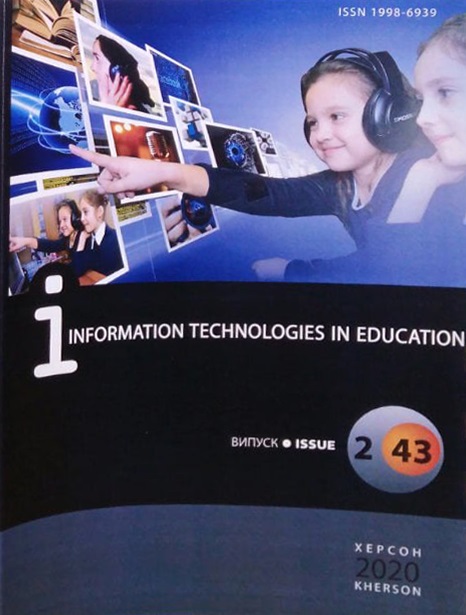CREATION AND DESIGN OF TESTS BY ICT
DOI:
https://doi.org/10.14308/ite000716Keywords:
ICT, future teachers, testing, electronic presentationsAbstract
The urgent task of teacher training in a certain profile is the formation of ICT competence for use in the learning process and future professional activities. The use of ICT will contribute to the formation of technological literacy, rational use of information resources, information culture of the future teacher. ICT skills will contribute to the positive development of the image of the modern teacher.The implementation of the acquired skills in the use of ICT in the practical activities of the future teacher allows first of all to present students with educational material. A quick and high-quality tool for future teachers is the use of electronic presentations, the possibilities of which are not limited to the presentation of educational information for students with animation effects. With the help of electronic presentations, you can organize the control of knowledge through questionnaires, testing or surveys of students.The article demonstrates the stages of designing tests with the help of electronic presentations, namely: creating a test with one or more correct answers, establishing correspondence between sets of questions and answers, determining the correct sequence of actions.This study focuses on the use of electronic presentations by students in the learning process not only to demonstrate educational material, but also the ability to organize knowledge control, which will contribute to the use of ICT for professional disciplines, teaching practice, individual tasks, writing term papers and qualifications.The use of electronic presentations by the teacher diversifies the learning process and helps to organize the student body. Possibilities of electronic presentations contribute to the formation of skills in the use of PCs in professional activities, as well as ICT competence and motivation of teachers of a certain profile.
Downloads
Metrics
References
2. Буйницька, О.П. (2011). Інформаційні технології та технічні засоби навчання: навчальний посібник, 240.
3. Глинський, Я.М. (2010). Практикум з інформатики, 210.
4. Гуревич, Р. С. & Кадемія, М.Ю. & Козяр, М.М. (2012). Інформаційно-комунікаційні технології в професійній освіті, 506.
5. Дибкова, Л. М. (2012). Інформатика та комп. техніка: посібник, 464.
6. Литовченко, І. В. & Максименко, С.Д. & Болтівець, С. І. (2010). Діти в Інтернеті : як навчити безпеці у віртуальному світі: посібник, 48.
7. Жалдак, М. І. (2005). Про деякі методичні аспекти навчання інформатики в школі та педагогічному університеті. Наукові записки Тернопільського національного університету ім. В. Гнатюка. Серія: Педагогіка, 6, 17-24.
8. Калініна, Л. М. & Носкова М.В. (2013). Gооgle-сервіси для вчителя. Перші кроки новачка: посібник,182.
9. Козак, Т.М. & Когут, У.П. & Вдовичин, Т.Я. (2017). Комп’ютерні інформаційні технології в освіті [для підготовки фахівців другого (магістерського) рівня вищої освіти]: практикум, 136 .
10. Морзе, Н.В. (2008). Основи інформаційно-комунікаційних технологій, 352.
11. Національна стратегія розвитку освіти в Україні на період до 2021 року. №344/2013 (25.06.2013).
12. Руденко, В.Д. (2012). Базовий курс інформатики, 368.
13. Смирнова-Трибульска, Є.М. (2007). Інформаційно-комунікаційні технології в професійній діяльності вчителя: посібник для вчителів, 525.
14. Томашевський, О.М. & Цегелик, Г.Г. & Вітер, М.Б. & Дудук, В.І. (2012). Інформаційні технології та моделювання бізнес-процесів: навчальний посібник, 296.
REFERENCES (TRANSLATED AND TRANSLITERATED)
1. V. Yu. Bykov (2008). Models of Organizational Systems of Open Education: monograph, 684.
2. Buynytska, OP (2011). Information technologies and technical means of education: textbook, 240.
3. Glinsky, Ya.M. (2010). Workshop on Informatics, 210.
4. Gurevich, R.S. & Kademiya, M.Yu. & Kozyar, M.M. (2012). Information and communication technologies in vocational education, 506.
5. Dibkova, L.M. (2012). Informatics and comp. technique: manual, 464.
6. Litovchenko, I.V. & Maksimenko, S.D. & Boltivets, S.I. (2010). Children on the Internet: how to teach security in the virtual world: a guide, 48.
7. M. I. Zhaldak (2005). About some methodical aspects of teaching informatics in school and pedagogical university. Naukovi zapysky Ternopilskoho natsionalnoho universytetu im. V. Hnatiuka, Seriya: Pedahohika, № 6, 17-24.
8. Kalinin, L.M. & Noskova M.V. (2013). Google services for teachers. The first steps of a beginner: a manual, 182.
9. Kozak, T.M. & Kohut, U.P. & Vdovychyn, T.Ya. (2017). Computer Information Technologies in Education [for training specialists of the second (master's) level of higher education]: workshop, 136.
10. Morse, N.W. (2008). Fundamentals of information and communication technologies, 352.
11. National strategy for the development of education in Ukraine until 2021. №344 / 2013 (25/06/2013).
12. Rudenko, V.D. (2012). Basic course of computer science, 368.
13. Smirnova-Tribulska, E.M. (2007). Information and communication technologies in the professional activities of teachers: a guide for teachers, 525.
14. Tomaszewski, O.M. & Tsegelik, G.G. & Wind, M.B. & Duduk, VI (2012). Information technology and business process modeling: a textbook, 296.
Downloads
Published
How to Cite
Issue
Section
License
This work is licensed under a Creative Commons Attribution-NonCommercial-ShareAlike 4.0 International License.






























